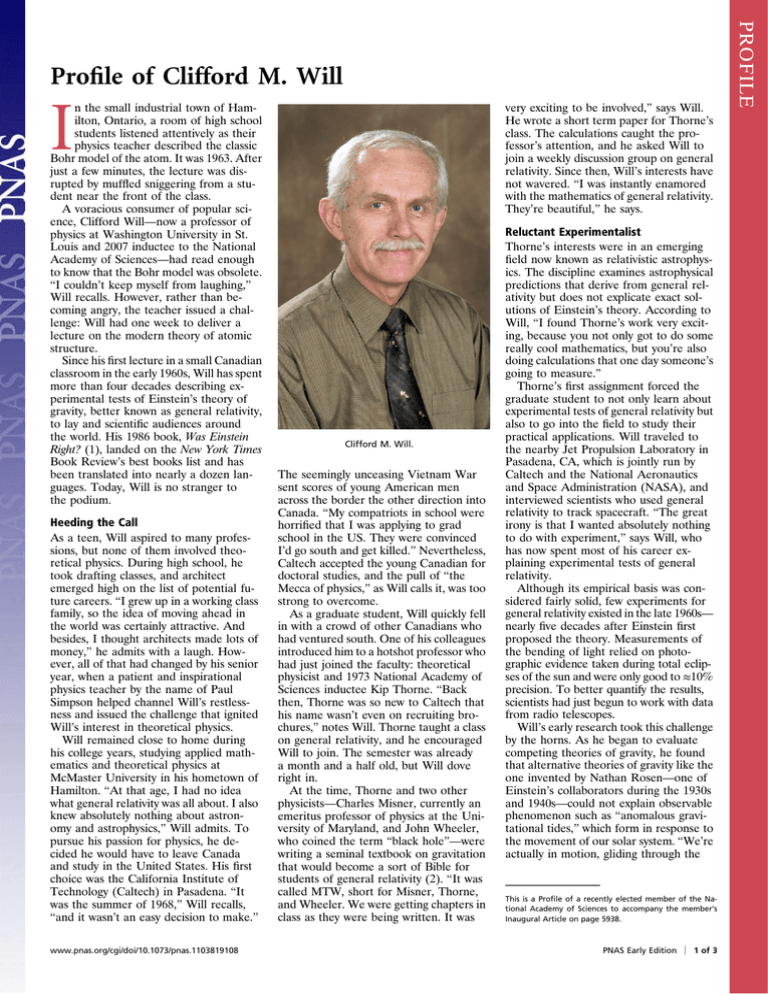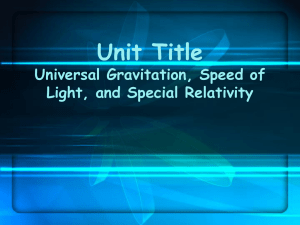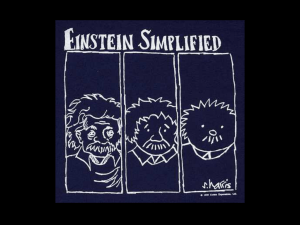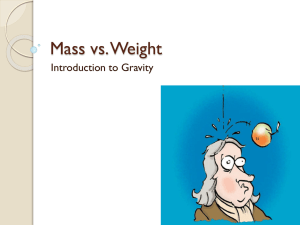I Profile of Clifford M. Will
advertisement

I n the small industrial town of Hamilton, Ontario, a room of high school students listened attentively as their physics teacher described the classic Bohr model of the atom. It was 1963. After just a few minutes, the lecture was disrupted by muffled sniggering from a student near the front of the class. A voracious consumer of popular science, Clifford Will—now a professor of physics at Washington University in St. Louis and 2007 inductee to the National Academy of Sciences—had read enough to know that the Bohr model was obsolete. “I couldn’t keep myself from laughing,” Will recalls. However, rather than becoming angry, the teacher issued a challenge: Will had one week to deliver a lecture on the modern theory of atomic structure. Since his first lecture in a small Canadian classroom in the early 1960s, Will has spent more than four decades describing experimental tests of Einstein’s theory of gravity, better known as general relativity, to lay and scientific audiences around the world. His 1986 book, Was Einstein Right? (1), landed on the New York Times Book Review’s best books list and has been translated into nearly a dozen languages. Today, Will is no stranger to the podium. Heeding the Call As a teen, Will aspired to many professions, but none of them involved theoretical physics. During high school, he took drafting classes, and architect emerged high on the list of potential future careers. “I grew up in a working class family, so the idea of moving ahead in the world was certainly attractive. And besides, I thought architects made lots of money,” he admits with a laugh. However, all of that had changed by his senior year, when a patient and inspirational physics teacher by the name of Paul Simpson helped channel Will’s restlessness and issued the challenge that ignited Will’s interest in theoretical physics. Will remained close to home during his college years, studying applied mathematics and theoretical physics at McMaster University in his hometown of Hamilton. “At that age, I had no idea what general relativity was all about. I also knew absolutely nothing about astronomy and astrophysics,” Will admits. To pursue his passion for physics, he decided he would have to leave Canada and study in the United States. His first choice was the California Institute of Technology (Caltech) in Pasadena. “It was the summer of 1968,” Will recalls, “and it wasn’t an easy decision to make.” www.pnas.org/cgi/doi/10.1073/pnas.1103819108 very exciting to be involved,” says Will. He wrote a short term paper for Thorne’s class. The calculations caught the professor’s attention, and he asked Will to join a weekly discussion group on general relativity. Since then, Will’s interests have not wavered. “I was instantly enamored with the mathematics of general relativity. They’re beautiful,” he says. Clifford M. Will. The seemingly unceasing Vietnam War sent scores of young American men across the border the other direction into Canada. “My compatriots in school were horrified that I was applying to grad school in the US. They were convinced I’d go south and get killed.” Nevertheless, Caltech accepted the young Canadian for doctoral studies, and the pull of “the Mecca of physics,” as Will calls it, was too strong to overcome. As a graduate student, Will quickly fell in with a crowd of other Canadians who had ventured south. One of his colleagues introduced him to a hotshot professor who had just joined the faculty: theoretical physicist and 1973 National Academy of Sciences inductee Kip Thorne. “Back then, Thorne was so new to Caltech that his name wasn’t even on recruiting brochures,” notes Will. Thorne taught a class on general relativity, and he encouraged Will to join. The semester was already a month and a half old, but Will dove right in. At the time, Thorne and two other physicists—Charles Misner, currently an emeritus professor of physics at the University of Maryland, and John Wheeler, who coined the term “black hole”—were writing a seminal textbook on gravitation that would become a sort of Bible for students of general relativity (2). “It was called MTW, short for Misner, Thorne, and Wheeler. We were getting chapters in class as they were being written. It was Reluctant Experimentalist Thorne’s interests were in an emerging field now known as relativistic astrophysics. The discipline examines astrophysical predictions that derive from general relativity but does not explicate exact solutions of Einstein’s theory. According to Will, “I found Thorne’s work very exciting, because you not only got to do some really cool mathematics, but you’re also doing calculations that one day someone’s going to measure.” Thorne’s first assignment forced the graduate student to not only learn about experimental tests of general relativity but also to go into the field to study their practical applications. Will traveled to the nearby Jet Propulsion Laboratory in Pasadena, CA, which is jointly run by Caltech and the National Aeronautics and Space Administration (NASA), and interviewed scientists who used general relativity to track spacecraft. “The great irony is that I wanted absolutely nothing to do with experiment,” says Will, who has now spent most of his career explaining experimental tests of general relativity. Although its empirical basis was considered fairly solid, few experiments for general relativity existed in the late 1960s— nearly five decades after Einstein first proposed the theory. Measurements of the bending of light relied on photographic evidence taken during total eclipses of the sun and were only good to ≈10% precision. To better quantify the results, scientists had just begun to work with data from radio telescopes. Will’s early research took this challenge by the horns. As he began to evaluate competing theories of gravity, he found that alternative theories of gravity like the one invented by Nathan Rosen—one of Einstein’s collaborators during the 1930s and 1940s—could not explain observable phenomenon such as “anomalous gravitational tides,” which form in response to the movement of our solar system. “We’re actually in motion, gliding through the This is a Profile of a recently elected member of the National Academy of Sciences to accompany the member’s Inaugural Article on page 5938. PNAS Early Edition | 1 of 3 PROFILE Profile of Clifford M. Will universe,” Will explains. As a result, measurements of gravity on Earth differ depending on whether they are taken in a direction parallel or perpendicular to our motion. This uneven gravity causes the Earth itself to distort, forming a bulge that points toward the direction of our movement through the universe. “This effect,” Will says, “is analogous to the tides induced on the Earth by the sun and the moon.” Some alternative theories of gravity have therefore been discarded, whereas the notion of general relativity has survived unscathed (3). Unpredictable Pulsar From Caltech, Will disembarked to the University of Chicago in 1972, where he served as an Enrico Fermi Fellow. There, he rubbed shoulders with another giant of modern astrophysics, Nobel Prize recipient Subrahmanyan Chandrasekhar. However, to the great physicist’s dismay, Will says, he continued studying experimental gravity. “As Chandra saw it, general relativity was just so incredibly mathematically beautiful that it simply had to be correct. He didn’t know why I’d even bother to investigate its validity instead of doing something, as he once said to me, ‘more useful.’ I knew that he was a bit disappointed that I didn’t work on his passion at that time: the vibrations of rotating neutron stars and black holes.” After completing his fellowship, Will accepted a position as an assistant professor at Stanford University in August of 1974, where he worked closely with theoretical astrophysicist Robert Wagoner. In those pre-Internet days, the International Astronomical Union notified scientists of new discoveries by sending out telegrams to all of the observatories. A few months into his appointment at the northern California institution, Will was working in his office when Wagoner burst in with exciting news. “He said, ‘Cliff, whatever you’re doing, you’ve got to drop it! They’ve just discovered a binary pulsar.’” Pulsars, which are rotating neutron stars that emit radio waves at regular intervals, had only been identified seven years earlier. By 1974, just a few hundred were catalogued. The identification of a binary pulsar, which consists of a pulsar and another astronomical object in orbit around one another, was a significant moment in the field. It led to the 1993 physics Nobel Prize for astrophysicists Joseph Taylor, Jr. and Russell Hulse, who were then at the University of Massachusetts in Amherst. Researchers from around the world immediately descended on Taylor and Hulse’s discovery. “It was clear that general relativity would play a very important part in understanding the orbit of these fast-moving objects,” Will explains. Astronomical objects in binary systems, even very fast moving ones, experience decays in their orbits until they eventually crash into one another. As the celestial bodies get closer and closer together, they lose orbital energy in the form of gravitational waves. General relativity and alternative theories of gravity predict differing outcomes of this process, so Will quickly wrote up the calculations (4). His ability to explain complex astrophysical phenomena, and specifically the Taylor-Hulse binary pulsar, eventually led to a surprise of his own—the delivery of a thick golden envelope to his office. The Nobel committee invited him to attend the 1993 ceremony, which he did with his wife Leslie. “I guess the trip was my reward,” Will recalls. “We had an absolutely unbelievable experience in Stockholm.” Inspiraling Calculations After seven years at Stanford, Will returned to the Midwest, accepting a tenured position in 1981 at Washington University’s Physics Department and McDonnell Center for Space Sciences. He has remained at the St. Louis, MO institution ever since; he quickly achieved the rank of professor in September 1985 and soon thereafter served a 10-year term as department chair. Will published his first book, Theory and Experiment in Gravitational Physics, shortly after joining Washington University (5). In it, he catalogs the many tools that he used and some he developed to understand experimental gravity, including explanations of alternative theories of gravity and how they compare with general relativity. His research also became more focused on one particular aspect of general relativity as he investigated the final orbits, also called the final inspirals, of astrophysical objects as they merge into one another as possible sources for gravitational waves (6). In the early 1990s, theoreticians began proposing ideas to detect these waves, which were first predicted to exist by Einstein in 1916. One such proposal involved creating laser interferometers that would use large lasers to fire beams of light at mirrors located several kilometers away. How the beams interfere with each other when they return, Will explains, “could show evidence for the existence of gravitational waves, if you knew how to look for the evidence.” Many obstacles existed before these interferometers could be created and return useful information. For example, the amplitude of gravitational waves decreases with the inverse of the distance from the source—so that by the time a wave from an inspiraling binary system reached Earth, it would be minuscule in size and difficult to detect in the face of instrumental noise. 2 of 3 | www.pnas.org/cgi/doi/10.1073/pnas.1103819108 The physicist, with a push from his former advisor Thorne at Caltech, realized that the first-order post-Newtonian calculations that they had been using, based on his 1976 work with Wagoner, would not be accurate enough to garner the maximum scientific output from the detections. “For the next several years, we calculated all of these higher-order corrections that involved unbelievably complicated mathematics,” Will says. By using two separate groups who worked independently of each other—one at Washington University and the other at the Institut d’Astrophysique de Paris— the teams were able to develop accurate predictions of the gravitational wave signal. “Working separately was the key so that we didn’t steer each other down a wrong path,” Will admits. The work helped solidify the theoretical foundation for the use of laser interferometers to detect gravitational waves (7). Detecting Gravity Will’s recent research has helped complete the picture of what gravitational waves might look like when produced by two merging black holes. His Inaugural Article is based on a lecture given nearly 50 years after his first. During the 2010 Subrahmanyan Chandrasekhar Centennial Symposium at the University of Chicago, he described “the unreasonable effectiveness” of post-Newtonian approximations of Einstein’s theory of general relativity (8). Much of Will’s career has focused on post-Newtonian theory as a tool to examine the consequences of general relativity, which describes gravity as a phenomenon that bends the fabric of space and time. Post-Newtonian approximations govern situations in which gravity is weak and movement is slow compared with the speed of light. The equations can describe the motion of celestial bodies in their orbits and the emission of gravitational waves, which are fluctuations in the distortion of space–time that propagate at the speed of light. However, because the calculations are approximations, there comes a point—when two black holes spin around each other, for example—that the post-Newtonian results themselves should break down and become inaccurate. In fact, another mathematical approach exists to describe this astronomical movement and the propagation of gravitational waves: numerical relativity, as it is called, does not rely on approximations. Physicists have used it to calculate the gravitational wave signal from the final orbits of the merging of two black holes. In his Inaugural Article, Will details how very-high-order post-Newtonian approximations agree with results from Ahmed numerical relativity. “We can look at the wave signal cycle by cycle, and the calculations correspond with each other over tens of cycles. You would’ve thought that they should fail to agree at some point, but they don’t,” he explains. This complete mathematical picture of gravitational waves has been deployed recently in gravitational wave detectors in Livingston, Louisiana, and in Richland, Washington, as part of the Laser Interferometer Gravitational Wave Observatory or LIGO project, which the National Science Foundation sponsors. NASA and the European space agency have plans to deploy a space-based antenna called LISA (Laser Interferometer Space Antenna) for the same purpose, possibly by 2020, and the Japanese space agency is working on a laser interferometer as well. “These detectors allow us to do both real astronomy and also fundamental physics,” says Will. Despite his excitement, Will has declined to participate in any of the experimental research at the detectors, preferring to—as many of his teachers have noted since his youth—march to the beat of his own drum. Although his previous mentors might be dismayed, Will plans to continue studying theories of gravity so that gravitational waves can be used as tools to test Einstein’s theory of general relativity. He also has a project underway to try and develop the next generation of great physicists. “One of my grandsons, he’s 15, and seems to have an affinity for science. So I’m working on him.” 1. Will CM (1986) Was Einstein Right? (Basic Books, New York, New York). 2. Misner CW, Thorne KS, Wheeler JA (1973) Gravitation (W.H. Freeman, San Francisco). 3. Will CM (1971) Theoretical frameworks for testing relativistic gravity. III. Conservation laws, Lorentz invariance, and values of the PPN parameters. Astrophys J 169:125–140. 4. Will CM (1977) Gravitational radiation from binary systems in alternative metric theories of gravitation: Dipole radiation and the binary pulsar. Astrophys J 214: 826–839. 5. Will CM (1981) Theory and Experiment in Gravitational Physics (Cambridge Univ Press, London). 6. Lincoln CW, Will CM (1990) Coalescing binary systems of compact objects to (post)5/2-Newtonian order: Late- time evolution and gravitational-radiation emission. Phys Rev D Part Fields 42:1123–1143. 7. Blanchet L, Damour T, Iyer BR, Will CM, Wiseman AG (1995) Gravitational-radiation damping of compact binary systems to second post-Newtonian order. Phys Rev Lett 74:3515–3518. 8. Will CM (2011) On the unreasonable effectiveness of the post-Newtonian approximation in gravitational physics. Proc Natl Acad Sci USA 108:5938–5945. Ahmed Farooq Ahmed, Freelance Science Writer PNAS Early Edition | 3 of 3







